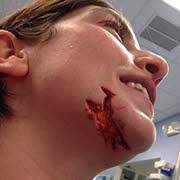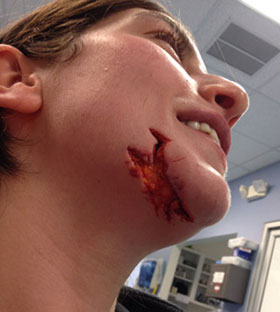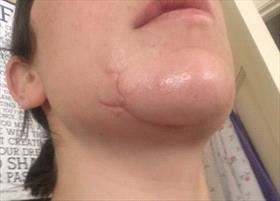

Photo courtesy of Dr. Sarah Cappello
After Dr. Sarah Cappello was bitten to the jaw bone by a patient — a 40-pound mixed-breed dog — the veterinarian had the presence of mind to scrub and flush her wound with antiseptic while waiting for a ride to a hospital emergency room during a blizzard.

Photo by Dr. Sarah Cappello
Ten months later, Cappello’s physical wound had healed nicely. Recovering from an attack requires emotional healing, as well. Cappello didn’t seek counseling, but said in retrospect that she probably should have.
The pit bull came into the veterinary clinic wearing a muzzle, but he was fine during a nail trim in the back. As the visit wound down, back in the exam room, the dog's owner, a small, older woman, removed the muzzle. Then she paused and asked the veterinary assistant to check one of the dog's nails.
The assistant turned toward the dog. By accident, she made eye contact — something to be avoided with a tense animal, which might view the look as a challenge.
At that moment, everything changed. "He came off the floor and jumped two to three feet and grabbed her head," recounted Dr. Katie Thompson, owner of a clinic near Tampa, Florida, where the attack happened. The veterinary assistant grabbed the dog's head with her hands, Thompson said, which then gave the dog a fresh target.
"Now he's chawing on her hands," Thompson said.
An associate veterinarian and other employees managed to pull off the dog. Clinic staff rushed their co-worker to a hospital emergency room.
The victim had several deep puncture wounds that reached to her skull. "The amount of blood was terrifying," Thompson said. There were broken bones in the hand and wrist that required surgery to repair. The woman was hospitalized for two weeks. Nerve damage and emotional damage lasted much longer.
Veterinary medicine is a dangerous profession. Most practitioners and their support crew have tales of being bitten. Many in the profession say their presumed affinity for animals leads the public — friends and family included — to overlook the psychological trauma inflicted by a bad bite and how difficult it can be to overcome the experience and remain in their career.
Some don't stay. Thompson's employee had been in school to become certified as a veterinary technician; she quit the program and left the field altogether. She became terrified of all dogs except her own. Last Thompson knew, the ex-employee was still in counseling.
Thompson understands the terror of a patient going rogue. A decade ago, a pit bull she'd treated several times before came off the floor during an exam without warning and hurtled toward her face.
The veterinarian pulled back as the dog's owner yanked him away, so the dog only grazed the bottom of her chin with his teeth.
Thompson recalled the owner remarking, "Oh, he's only ever done that with children." Stunned and speechless, Thompson walked out of the room, quietly closed the door and sank to the floor. Another doctor came up. "Are you OK?" he asked. "I was white as a ghost," Thompson said. "He went in to talk to the client."
For nearly a year afterward, Thompson had panic attacks and trouble breathing at work. To this day, she said, "It makes me want to vomit when I think about how casual I used to be around his face."
The dog, she said, was euthanized later after it bit a child's face.
In the case of the dog that attacked her employee, Thompson said the client wanted to continue bringing the dog to the clinic. The clinic refused. Thompson's husband, Don Thompson, a lawyer and clinic co-owner, vowed to never again let another staff member be hurt by a vicious patient.
The clinic instituted a policy of turning away any large dog that so much as raised a lip or was otherwise perceived by staff as a risk. Some mastiff breeds the clinic banned outright, owing to their intimidating size and breed histories as fighting animals — namely cane corsos, dogo Argentinos and presa Canarios.
The clinic elected not to ban pit bulls wholesale but decided to evaluate them individually, as some of its pit-bull patients are well-mannered.
Since instituting the policy about three years ago, Thompson said, the clinic has turned away only two clients. She has no qualms about the firm stance. "I'm not going to see your dangerous dog," she declared. "If that makes you mad, great, go tell all your other friends with man-eating dogs, too, so they won't come in here. I don't have to be the dog whisperer. It's not worth the $55 [exam fee]. If they hear it from enough vets, maybe they'll get the idea."
She added: "It is the height of arrogance for us as a profession and as humans to think we have that much control. We can do everything right and still have a response from this independent creature that we were not expecting and think we didn't provoke."
Thompson said the policy not only has helped employee morale, she believes it's boosted business by 25 percent. "A lot of my clients don't want to come in to the clinic with those dogs in the lobby," she said.
Banning dog breeds perceived to be dangerous is a familiar concept, but typically in the context of municipal, state or provincial laws. The breed-ban movement, which dates to the 1980s, is controversial. Critics include the American Veterinary Medical Association. In a statement titled "Why breed-specific legislation is not the answer," the AVMA says: "It's not the dog's breed that determines risk — it's the dog's behavior, general size, number of dogs involved and the vulnerability of the person bitten that determines whether or not a dog or dogs will cause a serious bite injury."
The AVMA has no statement specifically pertaining to breed bans by private practices.
Thompson and her husband aren't unique among practice owners in their decision to turn away certain breeds. Dr. Warren Kaplan declined to see Rottweilers in a practice he once owned on Long Island in New York.
Kaplan's view of Rottweilers as an unstable breed developed over time. When he first started practicing in 1969, Rottweilers were fairly rare. As the breed gained in popularity and he began seeing them more frequently, he observed that the dogs might be sweet as puppies but would change around age 2, especially males. Dogs that hadn't previously been a problem became difficult to handle.
"I'm not talking about a troublesome dog that can be muzzled or sedated. I'm not talking about the usual frightened dog," Kaplan said. "I'm talking about a dog that will tear your arm off."
His concerns about certain patients caused him to lose sleep days in advance of appointments with them. His staff became uneasy, too.
"I started to realize all I wanted to do was get [the dog] out of there," Warren recalled. "I realized I just wasn't going to see these dogs if I can't do right by them. There was no way I could hospitalize a dog that was really dangerous. I'm not going to put that dog in a cage. I won't ask my staff to put life and limb in danger."
Moreover, he said, "It's not fair to the client. They're hiring me to give them their best."
The policy was in place from 2003 until Kaplan sold the practice in 2006.
Overcoming and preventing attacks
- Following an attack, obtain crisis counseling, the sooner, the better.
- Report bites to local authorities.
- Have a staff discussion on whether anything was done incorrectly and if so, how to avoid such mistakes in the future.
- Provide or obtain training on how to identify and handle aggressive dogs and cats.
- Learn more about dog behavior and body language. Recommended sources include materials by Dr. Sophia Yin and Turid Rugaas.
- On new-client intake forms or when taking new-patient history, ask about aggression and biting.
- Heed the internal voice that says "I should muzzle this dog." If a dog seems too agitated, ask the client to reschedule the appointment and to muzzle the dog before it enters the clinic next time.
- Realize that muzzles may not stay in place on all head shapes. Dogs that need muzzles should be physically restrained also.
- Keep a photo of an injured veterinarian or technician available in exam rooms to show clients who balk at muzzles or joke about your precautions. Show such photos to friends who tease you.
- Be aware that sedatives may reduce bite inhibition in some patients.
- Document aggressive behavior in the medical record.
Boning up on animal behavior
Banning breeds is by no means a universal response by veterinarians who have had bad experiences. Some try to get better at heading off trouble before it rears.
Take Dr. Steven Immerblum, a practitioner in upstate New York. He's had bad bites twice in the past 30 years. The first involved a 105-pound malamute that needed treatment after a dog fight. The dog calmly tolerated the veterinarian flushing his wounds, including injuries in the mouth. As the owner and dog turned to leave the room, Immerblum petted the dog on the rump — nowhere near the wounds.
The dog swung around and "attempted to kill me," Immerblum recounted. The animal didn't let up the attack until Immerblum managed to compress the dog's carotid, causing it to lose consciousness. The veterinarian came away with severe puncture wounds on his arms and legs.
A decade later, a chow bit Immerblum on the face as the doctor lifted her off an exam table. The wound required 26 sutures.
Today, Immerblum looks at the incidents as lessons learned. He's since boned up on animal behavior; he said he believes he could have avoided both attacks had he handled the situations differently.
Now he is careful about which staff member is assigned to restrain a patient, and how. Any dog that makes him uneasy, such as by its body language, Immerblum takes for a quick walk at the beginning of the appointment. He has found that dogs that follow his commands for heeling and sitting are less likely to give trouble.
Immerblum recalls only two dogs that he couldn't walk normally on a leash — a 50-pound Jindo and a 110-pound Rottweiler. The Jindo could be controlled on leash with a straight arm held away from his body. Not so the Rottweiler. It is the only dog Immerblum said he has refused to treat in his 35-year career. (The owners of both dogs later realized the dogs were dangerous, he said, and had them euthanized.)
"We have a team of very experienced and behaviorally astute employees, so we do often handle difficult dogs," Immerblum said.
One way the clinic handles difficult patients, he said, is by sedating them. To keep an animal still for an injection of sedative, the person handling it may attach it by leash and slip collar to a chain-link fence or partially pull it through a door, he said.
Like Immerblum, Dr. Sarah Cappello coped with an attack by increasing her own knowledge and awareness of animal behavior and measures she could take to protect her safety and the safety of staff.
Cappello's frightening experience happened when she was just two years out of school, working at a busy 24-hour hospital. Her patient was a 40-pound hound mix that needed attention after eating a large amount of ibuprofen.
On a message board of the Veterinary Information Network, an online community for the profession, Cappello shared this account in a discussion about overcoming patient attacks:
"I … did an entire exam, complete with opening his mouth and palpating his abdomen, and the dog was fine — a little shy/timid, but absolutely no hint of aggression. I finished my exam, and the dog turned and started to walk back towards his owner. I stepped back and started to stand up. When I was about halfway up, the dog spun, let out an unbelievable snarl/growl and launched himself through the air at my face."
Cappello came away from the encounter with a bloody laceration across her cheek, jaw and neck. Her jaw bone was visible through the broken skin.
"One midnight ER trip, a fantastic surgeon and 10 months of healing and scar care has left me with a very subtle scar along my jaw that doesn't even hint at the gaping open jagged horrible wound it initially was," Cappello reported.
To manage the mental trauma, Cappello "obsessively analyze[d] the situation from every angle possible and spoke to a number of vets and behaviorists about the situation and the dog. I tried to understand exactly what happened and how and what, if anything, I could've done to prevent it."
She determined ultimately that there was nothing she could have done under the circumstances to avoid the bite. However, there are steps hospitals can take to keep everyone safer, she said. "I was working in a hospital that was extremely understaffed, way too busy, disorganized, and some of the staff was not well trained or experienced enough," she related. "All of those factors combined meant that I ended up alone in a room with a poorly restrained dog. I now know that is never OK."
Now working in a different hospital, Cappello follows these practices: "I'm quick to muzzle, quick to sedate, quick to bring dogs back to treatment for exams with multiple people to restrain, and ALWAYS ensure someone has the head when I'm handling the dog, and if I have any doubts, I just stop and reconfigure until I'm comfortable."
For a while, every dog made her nervous, but she soon became more comfortable in her ability to control situations. Aggressive or stressed dogs still make her nervous, though, and she's prone to flashbacks and momentary panic. "When that happens I ask someone else to hold the dog, someone else to do the procedure … to place the muzzle, or we go to sedation," she wrote. "A little bit of healthy fear is a good thing, as long as it's not debilitating and I can still do my job."
She added: "The upside to all of this is that my staff always say they feel incredibly safe when working with me and have a lot of confidence in my ability to control situations with aggressive animals and to keep everyone safe and protected."
Part 2: When safety, learning conflict in veterinary school